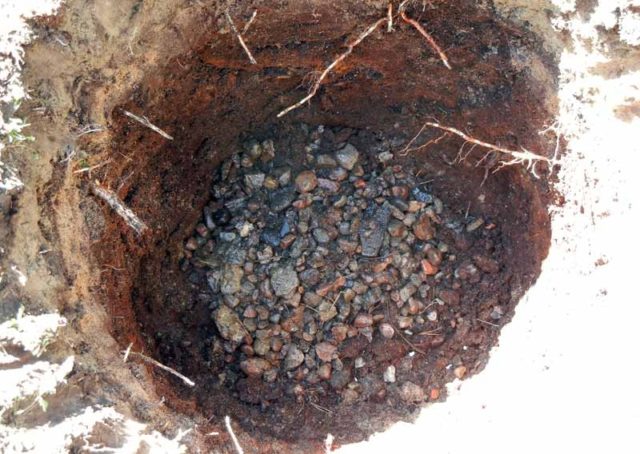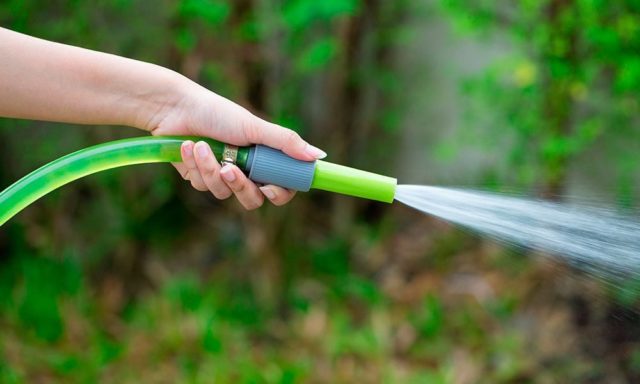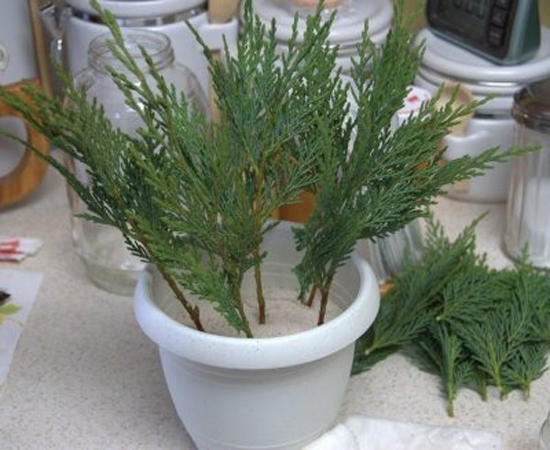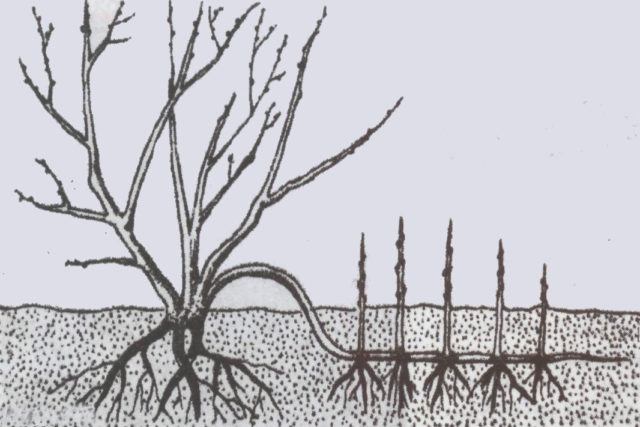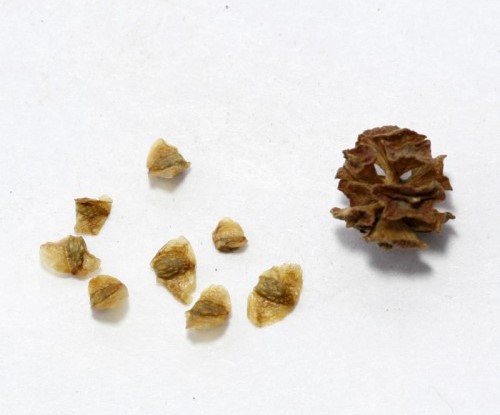Content
- 1 What is the difference between cypress and cypress
- 2 Cypress root system
- 3 How fast the cypress grows
- 4 What cypress grows
- 5 How cypress winters
- 6 How to plant a cypress in the country
- 7 Caring for cypress trees in the garden
- 8 Cypress propagation
- 9 Why does cypress dry
- 10 What to do if the cypress dries up
- 11 Diseases and pests
- 12 Conclusion
Planting a cypress tree and caring for it in the garden is not particularly difficult. Many landscape designers and simply lovers of ornamental plants use these evergreen trees to decorate gardens, park areas and adjoining territories.
Cypress looks great in both individual and group plantings, and with proper care it can become a real garden decoration.
What is the difference between cypress and cypress
Despite the similarity of names, cypress and Cypress have certain differences, since they are 2 completely different trees, although they belong to the same family. You can distinguish them from each other by the shape of the branches and by the cones. Cypress branches are flatter, and the cone contains only 2 seeds covered with scales. Cypress cones are much larger in size, and the number of seeds in them is much higher. Its needles are not flat, like those of a cypress, but faceted, to the touch remotely reminiscent of a pencil.
Cypress root system
The cypress root system is located mainly horizontally, over time, expanding strongly in breadth. At a young age, the roots of this tree grow quite actively, over time this process slows down.
Nevertheless, when planting, this factor must be taken into account, therefore, neighboring seedlings are planted from each other at a distance of at least 1, or even 2 m, so that adult trees do not compete with each other.
How fast the cypress grows
The growth rate of a cypress tree directly depends on its type, variety, as well as on the quality of care for it. In addition, the growing conditions of the tree, the climatic features of the area, the nature and composition of the soil are important. Depending on all these values, the annual growth of a cypress tree can be from 20 to 70 cm per year. As a rule, fast-growing varieties of this evergreen coniferous tree have the prefix fastigiata in their name.
What cypress grows
In total, 7 species of cypress are described in nature. In addition, there are several hundred varieties bred for decorative purposes. The largest cypress on a trunk in the wild can reach a height of 70 m, while dwarf cultivars are often grown as indoor flowers in pots.
The main growth indicators of some types of cypress are shown in the table below:
Cypress type | Height of an adult tree, m |
Pea | 30 |
Lawson | 70 |
Stupid | 50 |
Tuyuid | 25 |
Nutkansky (Yellow) | 40 |
How cypress winters
Most varieties of this tree can withstand frosts down to - 20 ° С, and pea varieties - up to - 25 ° С. This makes it possible to grow them in the southern regions of Russia. Young plants are more prone to freezing and can hardly withstand a drop in temperature even to -10 ° C, therefore, in the Moscow region and in central Russia, overwintering of cypress in the open field is not allowed.
In these regions, a different tactic is used, growing trees as decorative, in pots or flowerpots.In the warm season, they are exhibited in the garden, and for the winter they are removed indoors.
How to plant a cypress in the country
Cypress is often used as elements of landscape design when decorating gardens, personal plots, adjoining territories, or to decorate a summer cottage. They can be planted along alleys, paths; many use it as separate architectural elements of the garden. The cypress tree looks great on the site as a background for flowers, for example, when growing rose bushes. Before planting a cypress, it is necessary to decide on the choice of the required variety, and also take into account all the nuances associated with the size of the future tree, the conditions for its growth and the possibilities for caring for it.
Landing site selection
The cypress does not like heat and bright sun, the best place for it is partial shade. The only exceptions are those varieties whose needles have a golden hue; such trees prefer open sunny places. Do not plant it in lowlands, where cold air accumulates, frosts are harmful for it. The cypress grows well on light sandy, slightly acidic soils with a sufficient amount of moisture, lime and heavy clay soils are not suitable for this tree.
Soil preparation
Planting holes for cypress trees should be prepared in advance, in the fall. Usually their depth is 0.7-1 m, diameter - 0.6-0.8 m.At the bottom, it is imperative to lay a layer of drainage from broken brick or large rubble with a layer 0.2 m thick.
The free space between the stones can be covered with sand. To backfill the roots of the cypress, a special soil mixture is prepared, consisting of soil, sand, peat and humus, taken in a ratio of 1: 1: 0.5: 1.5.
Preparation of planting material
Cypress seedlings are purchased, as a rule, in specialized stores or nurseries. In this case, their root system must be closed, that is, the seedling must have a clod of earth on the roots or be sold in a special container. The plant itself should have a healthy appearance, the needles of the tree should be green without brown spots.
Cypress planting rules
Unlike fruit trees, which are planted mainly in autumn, cypress is usually planted in April or May, sometimes even in early summer. At this time, the soil warms up enough. Before planting, a peg is driven into the bottom near the center of the pit, which will at first serve as a support for the future tree. The soil in the planting pit, as well as the clod of earth that is on the roots of the cypress seedling, must be impregnated with Kornevin's solution (root formation stimulator). After that, the seedling is placed in the planting hole next to the garter peg and covered with nutritious soil, keeping it strictly vertical. From time to time, the soil around the tree trunk is slightly compacted so that no voids form. In this case, the root collar should be 10-12 cm above ground level.
The planted plant must be watered abundantly. After the soil has shrunk, it is necessary to add soil so that the root collar of the tree is flush with the ground. The seedling must be tied to a peg to protect it from possible wind damage. The soil of the trunk circle must be mulched with peat, needles or small tree bark, this will significantly reduce moisture loss. After firm rooting, the tree can be untied from the support, and the peg itself can be pulled out.
Caring for cypress trees in the garden
In order for the cypress to retain its beautiful appearance, it needs some care. Be sure to carry out the following activities:
- watering;
- top dressing;
- loosening the soil;
- mulching the trunk circle;
- pruning;
- preventive spraying against pests and diseases.
Watering and feeding
Cypress loves moisture, however, it does not tolerate an excess of it. Mature trees should be watered at least 1-2 times a week at the rate of 1 bucket of water for each.In dry hot weather, this figure should be doubled. Cypress reacts well to high humidity, so trees must be sprayed, especially in drought. Young trees at this time are also sprayed with water, since the heat significantly slows down their growth and development. After watering, it is advisable to mulch the soil around the trunk with peat, tree bark or wood chips to reduce moisture evaporation.
For feeding cypress, complex mineral fertilizers are most often used, introducing them in the form of an aqueous solution by the root method into the tree trunk circle. Usually, feeding is done once every 2 weeks from spring to mid-summer. Since August, fertilization is stopped so as not to stimulate the plant to grow in the pre-winter period.
Pruning
Cypress easily tolerates pruning. For the first time, it is pruned no earlier than a year after disembarkation or transplantation. In the spring, after removing the winter shelter, they carry out sanitary cleaning, cutting off the frozen ends and broken branches. At the same time, a formative pruning of the tree is also carried out, giving its crown a corresponding pyramidal or conical shape.
In the fall, after the end of the period of active growth, sanitary pruning is repeated, removing dried or damaged branches. At the same time, the growth of the current year is cut by 1/3, while maintaining the selected shape of the crown of the tree.
Cypress transplant
Due to the branched system of horizontal roots, transplanting a cypress tree is associated with certain difficulties. To carry out the procedure painlessly, at least six months before the proposed transplant (or earlier), the tree is dug on a shovel bayonet, gradually cutting its roots. The procedure itself is carried out in mid-spring. The tree is transplanted together with a lump of earth on the roots, and the sequence of actions is similar to planting a seedling. After transplanting the plant, it is necessary to water it abundantly.
Shelter for the winter cypress
The cypress root system is located close to the surface, and in case of severe freezing of the soil, it can be damaged. To protect it, the root zone around the tree trunk is covered with a thick layer of mulch made from sawdust, fine tree bark or other porous materials. When preparing a cypress tree for winter, spruce branches are used as a shelter for the aerial part of the plant, or a special shelter is built around the tree. Most often they are a wooden frame covered with non-woven covering material.
Cypress propagation
You can propagate cypress on your own. To do this, you can use one of the following methods:
- seed;
- cuttings;
- layering from the mother tree.
It must be remembered that the seed method will retain only the specific characteristics of the tree, all varietal components will be lost. For propagation of varietal species of cypress, vegetative propagation methods should be used, for example, cuttings.
Propagation of cypress by cuttings
To harvest cypress cuttings, use the lateral branches of adult trees, from which the apical shoots from 5 to 15 cm long are cut off.The lower part of the cuttings is freed from needles, and then planted in a container filled with a mixture of perlite and sand (in a ratio of 1: 1) with the addition of a small the amount of coniferous bark. The nutrient substrate is moistened, then the container is covered with plastic wrap on top, simulating greenhouse conditions. After about 4-8 weeks, the cuttings will take root if the humidity is kept constant, close to 100%.
It is allowed to plant cuttings in open ground. At the same time, they are covered with plastic bottles with a cut off neck.If rooting is going well, the cuttings can be left in the open field for the winter, after covering them first. If root formation is weak, the plants are taken to a warm room for wintering.
Layers
To obtain layering, you need to gently bend one of the lower branches of the cypress to the ground. An incision is made at its lowest point, which will later become the center of root formation. To prevent the walls of the incision from closing, a small pebble is placed between them. The shoot is carefully laid in a dug trench, fixed with a wire brace and covered with earth. Together with watering the mother tree, the place of the future layer should also be watered.
By the fall, the layering will form its own root system, but you should not rush, you need to leave it to winter with the mother tree. It will be possible to cut it off from the donor branch next spring, in April, and then transplant it to a permanent place in the usual way.
Seeds
Correctly harvested and dried cypress seeds remain viable for 15 years. They are stratified before planting. For this, the seeds are placed in a container with a light soil substrate and buried in the snow. You can also use a regular refrigerator. In the spring, the container is opened and placed in a warm place (+ 20-23 ° C), well lit, but without direct sunlight. If done correctly, seedlings will appear in a few weeks.
When the plantings are thickened, the seedlings need to dive. As soon as the air temperature rises above 0 ° C, the container with the planting material must be taken outside daily, gradually hardening the plants. After the seedlings get stronger, they are planted in open ground, in a slightly shaded place. During the first winter, seedlings should spend the winter under cover.
Why does cypress dry
The main reason for the drying out of the cypress is a lack of moisture. Often, the needles of a plant evaporate more water than its roots can absorb. Therefore, it is so important to regularly spray the crown of the tree, especially in hot weather.
If the yellow color appearing on the needles is not associated with the peculiarity of the cypress variety, this may indicate a lack of magnesium in the soil or an excess of calcium. Soil alkalization, which is indicated by increased calcium content, can be removed by adding high peat to the soil, which gives an acidic reaction. It is possible to accurately determine the mineral composition of the soil and the level of acidity using chemical analysis.
In addition to insufficient watering and imbalance in nutrition due to poor-quality soil, diseases and pests can cause yellowing and wilting of cypress trees.
What to do if the cypress dries up
Since there can be several reasons for the drying of the cypress, the method of solving the problem must be chosen with this in mind. First of all, you need to exclude the most obvious - a lack of moisture. To do this, watering is increased, and the irrigation of the tree crown is increased. If the wilting process does not stop, you need to check the composition of the soil, as well as the presence of diseases or the appearance of pests in the plant.
Diseases and pests
Cypress is sick relatively infrequently. Among the diseases, the most dangerous is late blight root rot, which appears due to stagnation of water in the roots of the plant. At the same time, no traces of the disease are observed on the root collar of the tree. Withering begins with individual branches, gradually the whole tree becomes gray and dies. Fighting root rot is possible only at an early stage of its appearance. To do this, the cypress is dug out, the roots are washed, the rot is cut to a healthy root. At a later stage, such a measure will not help; the tree must be destroyed.
Among the pests that most often attack the cypress, the following insects are dangerous:
- Aphid.
- Spider mite.
- Shield.
- False shield.
- Thuvaya mining moth.
To combat these insects, multiple spraying of trees with various preparations is used: acaricides, insecticides, complex preparations of a wide spectrum of action. However, it is not always possible to achieve complete destruction of pests. Sometimes a severely affected plant must be dug up and burned to prevent insects from spreading to neighboring trees.
Conclusion
Planting a cypress tree and caring for it in the garden is within the power of not only experienced gardeners, but also beginners. This decorative evergreen tree does not require increased attention and care, and agricultural techniques when working with it are the simplest. A positive point is the variety of its varieties, because thanks to this, you can always choose the plant that is best suited for decorating a garden, park or personal plot.



